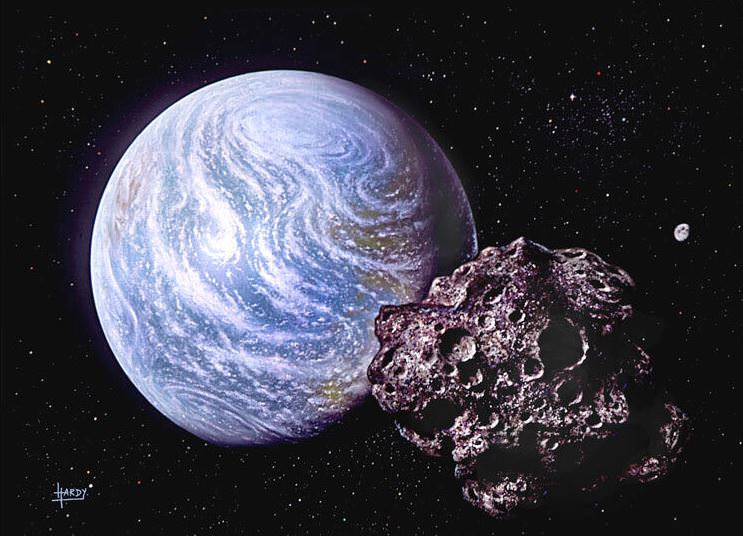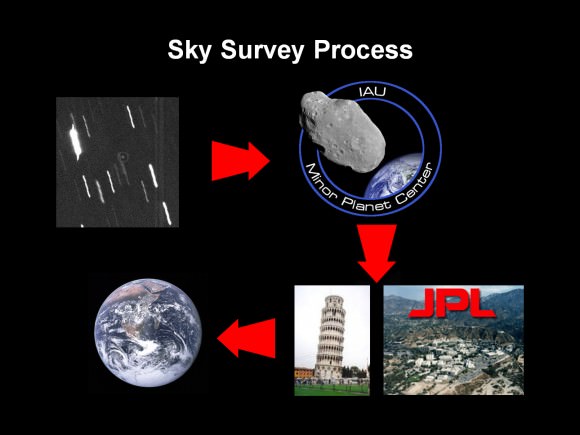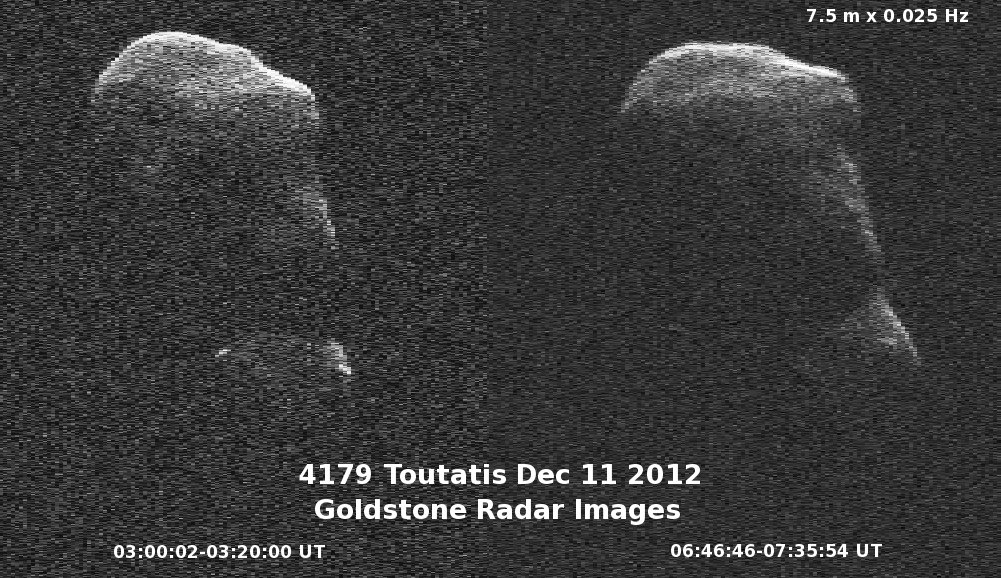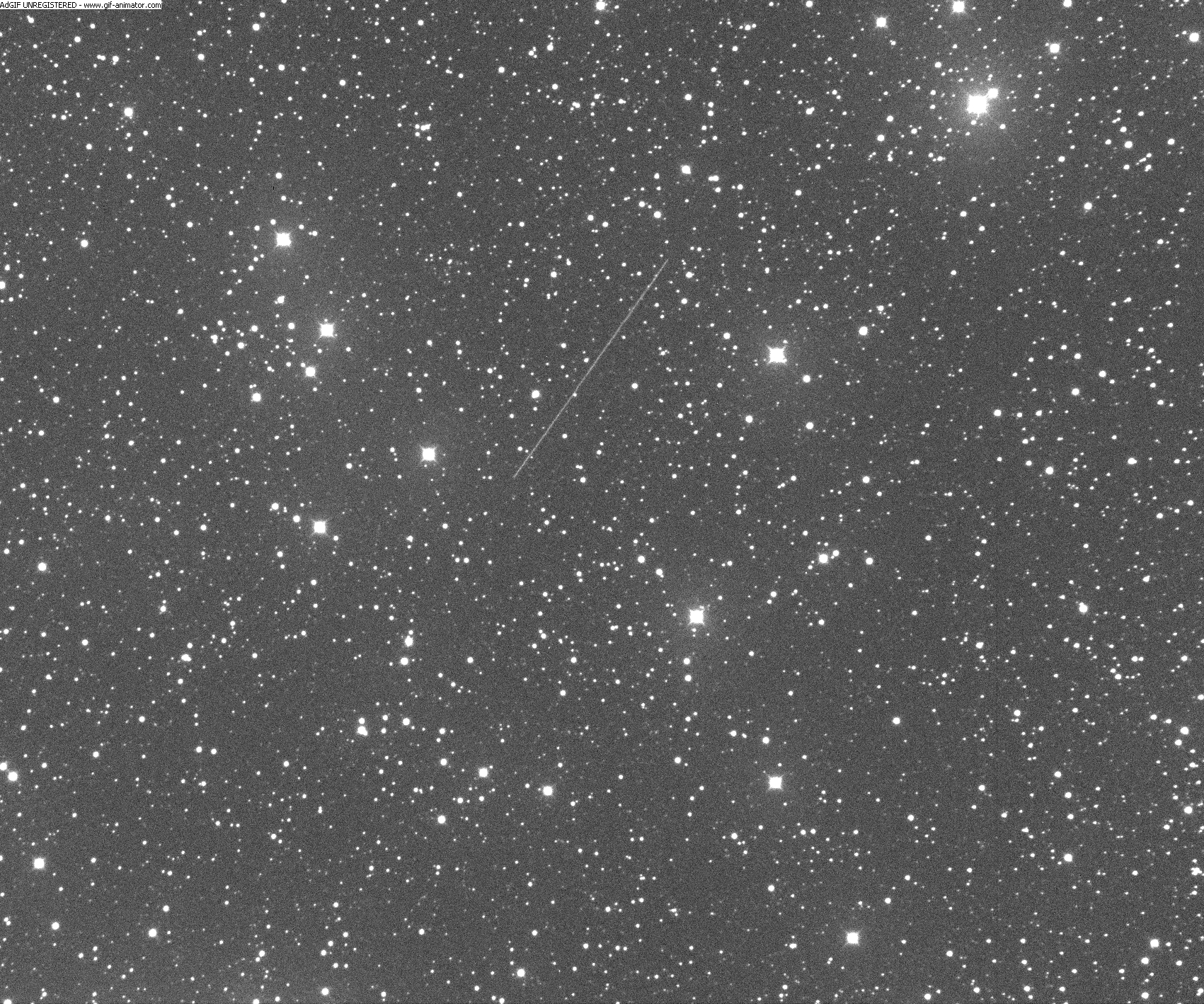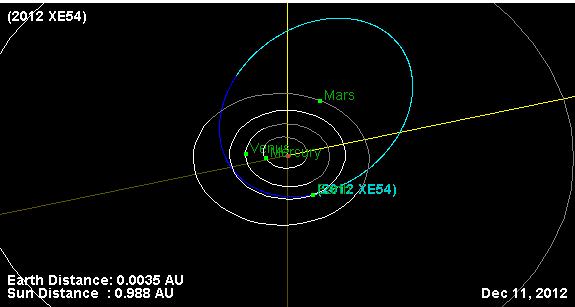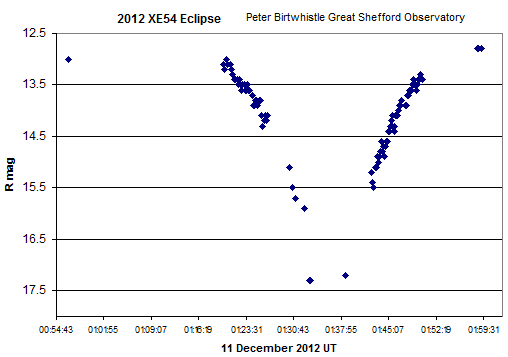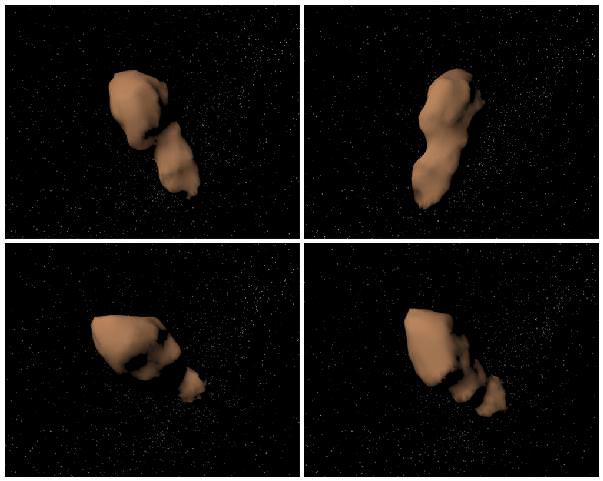Here’s the latest video of the fast approaching asteroid named 2012 DA14 that’s screeching towards our planet and set to give us all a very close shave this afternoon, shortly after 2 PM EST. NASA TV will provide Live coverage starting at 2 PM EST. Continue reading “Latest Video of Asteroid 2012 DA14 Steaking Towards Close Shave with Earth – as Meteor explodes over Russia”
Astronomers Provide a Peek at Asteroid 2012 DA14
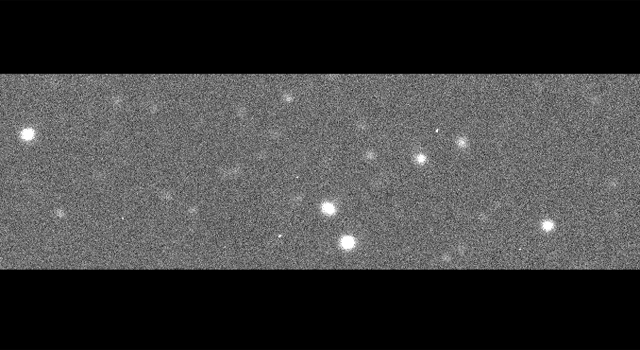
Our friends Ernesto Guido and Nick Howes from the Remanzacco Observatory — along with Edward Gomez from the Faulkes Telescope — have nabbed a look at asteroid 2012 DA14 as it was approaching Earth on Feb. 14, 2013 at around 11:06UT. Guido and Howes said the asteroid was about 748,000 kilometers (465,000 miles) from Earth, and was only about magnitude 17 in brightness. The animation was created from 3 images taken by Faulkes Telescope South through a 2.0-m f/10.0 Ritchey-Chretien telescope with a CCD. (You may have to click on the image for the animation, depending on your browser.)
See their website for some unique animations and detailed info about tomorrow’s (Feb. 15, 2013) close flyby of this 50 meter- (164 feet-) wide space rock.
Watch Live as Asteroid 2012 DA14 Whizzes Past Earth
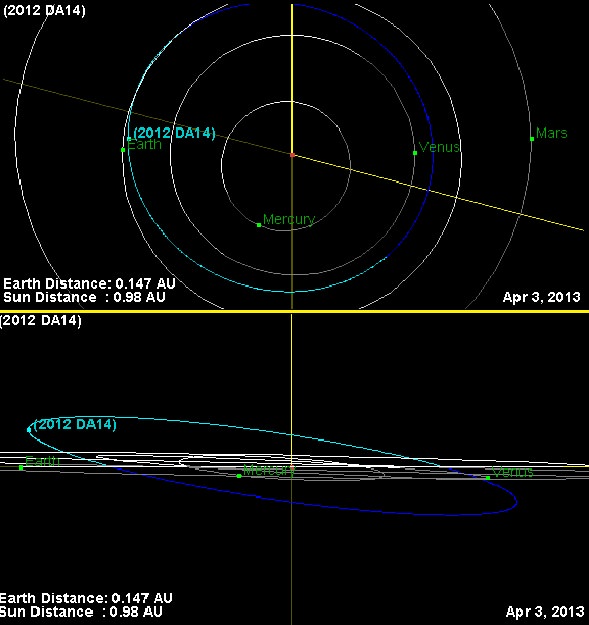
Want to keep tabs on asteroid 2012 DA14 as it whizzes past Earth tomorrow (Feb. 15)? NASA TV and several online astronomy outlets will be tracking this asteroid as it makes its record-setting close shave. This marks the first time there has been an asteroid of this size passing this close that we’ve known a year beforehand. No, there’s no chance it will hit us, but it will come within 27,630 kilometers (17,168 miles) from the surface of the Earth, inside the ring of geosynchronous satellites girdling our planet Earth. It will closest to Earth at 2:25 p.m. EST (19:25 UTC).
Find out how you can watch on TV or online as this 50 meter- (164 feet-) wide space rock goes by:
NASA Television will provide commentary starting at 2 p.m. EST (11 a.m. PST, 19:00 UTC) on Friday, Feb. 15. This flyby will provide a unique opportunity for researchers to study a near-Earth object up close. You can either watch the feed below, or on your own television if you get NASA TV, or online here.
Video streaming by Ustream
The half-hour broadcast from NASA’s Jet Propulsion Laboratory (JPL) in Pasadena, Calif., will incorporate real-time animation to show the location of the asteroid in relation to Earth, along with live or near real-time views of the asteroid from observatories in Australia, weather permitting.
Here are other webcasts that are planned:
Virtual Telescope Project, Italy
Astronomer Gianluca Masi from the Virtual Telescope Project will provide live views of asteroid 2012 DA14 from Ceccano, Italy, beginning at 5 p.m. EST (2200 GMT). You can watch at this link.
Bareket Observatory, Israel
The Bareket Observatory in Israel will have a free live webcast of the 2012 DA14 asteroid flyby on Friday from at 2 p.m. to 3:30 p.m. EST (19:00 to 20:39 UTC).
Here’s the link to this webcast.
“The observatory will offer a special live view of the close approach, using a remote telescope coupled with a cooled CCD camera, accessible via the Internet,” said the observatory team.
Slooh Space Camera, Africa and Arizona
The Slooh Space Camera webcast will provide views of the asteroid from observatories in the Canary Islands (off the west coast of Africa) and in Arizona. They will also be viewable on iOS and Android mobile devices. Just go to the Slooh website on your device.
Slooh’s webcast will begin on the 15th at 6 p.m. PST / 9 p.m. EST / 02:00 UTC (2/16). The webcasts will feature real-time commentary by Slooh Space Camera’s Paul Cox, astronomer Bob Berman of Astronomy Magazine, and Matt Francis, the manager of Prescott Observatory at Embry-Riddle University in Arizona.
See an Asteroid’s-Eye-View of Friday’s Close Approach Between 2012 DA14 and Earth
If you haven’t heard yet, this Friday, February 15, 2013 will be a close flyby of an asteroid named 2012 DA14. It’s turning out to be a highly anticipated event, as it will pass just 27,630 kilometers (17,168 miles) from the surface of the Earth, well within the range of many Earth-orbiting satellites. If you could watch the action from the vantage point of space, what would this flyby look like? Analytical Graphics, Inc., a company that creates modeling and analysis software for space, defense and other areas, has put together an animation which includes the asteroid’s trajectory as it approaches Earth, a closeup of the asteroid during its closest approach, a highlighted portion of Earth orbit that it is expected to pass through, and other interesting data.
The video above also provides a view of the asteroid’s pass by Earth below the geosynchronous orbit belt, how it will crossing the equatorial plane from South to North, a size comparison, and how the Earth/Moon will perturbs the asteroid’s orbit.
This asteroid is about 50 meters (164 feet) in size. Asteroid experts, including NASA’s Don Yeomans has , said there is no possibility of this asteroid hitting Earth, and they have also effectively ruled out the chance of any satellites getting hit.
The asteroid will not be bright enough to be visible with the unaided eye, but will be visible to backyard astronomers with good telescopes. The timing of the pass will allow viewers in eastern Europe, Africa, Australia and New Zealand to have the best chance of seeing this asteroid.
See our complete guide on how to see Asteroid 2012 DA14.
This asteroid must be stirring the imaginations of many; already renowned and award-winning space artist David A. Hardy has created a painting of his impression of 2012 DA14’s approach to Earth:
Thanks to Hardy for allowing us to post his lovely artwork. You can see more at his website, and he did an interview with us last year, which you can read here.
45 meter Asteroid to Skirt Very Near Earth on Feb 15
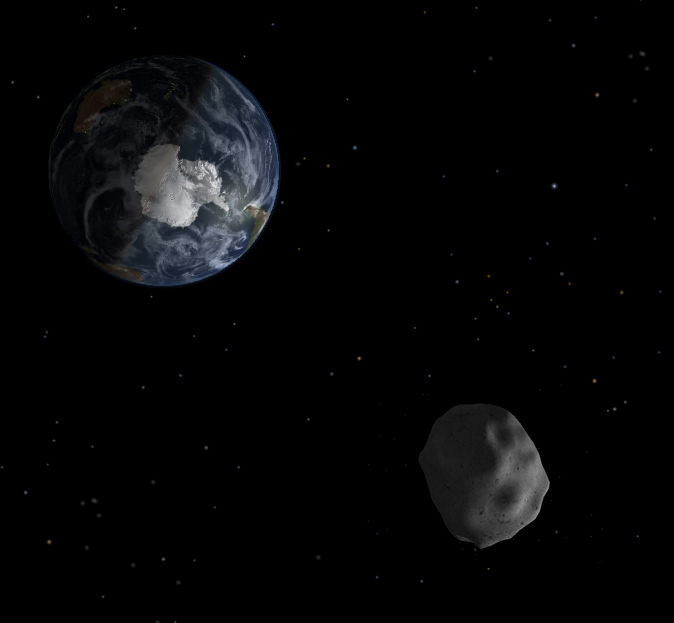
Our home planet is due for a record setting space encounter on Friday (Feb. 15) of this week, when a space rock roughly half a football field wide skirts very close by Earth at break neck speed and well inside the plethora of hugely expensive communications and weather satellites that ring around us in geosynchronous orbit.
“There is no possibility of an Earth impact” by the Near Earth Asteroid (NEO) known as 2012 DA 14, said Don Yeomans, NASA’s foremost asteroid expert at a media briefing. Well that’s good news for us – but a little late for the dinosaurs.
At its closest approach in less than 4 days, the 45 meter (150 feet) wide Asteroid 2012 DA14 will zoom by within an altitude of 27,700 kilometers (17,200 miles). That is some 8000 km (5000 miles) inside the ring of geosynchronous satellites, but far above most Earth orbiting satellites, including the 6 person crew currently working aboard the International Space Station.
Although the likelihood of a satellite collision is extremely remote, NASA is actively working with satellite providers to inform them of the space rocks path.
The razor thin close shave takes place at about 2:24 p.m. EST (11:24 a.m. PST and 1924 UTC) as the asteroid passes swiftly by at a speed of about 7.8 kilometers per second (17,400 MPH)- or about 8 times the speed of a rifle bullet. For some perspective, it will be only about 1/13th of the distance to the moon at its closest.
“Asteroid 2012 DA14 will make a very close Earth approach, traveling rapidly from South to North and be moving at about two full moons per minute,” said Yeomans, who manages NASA’s Near-Earth Object Program Office at the Jet Propulsion Laboratory in Pasadena, Calif. “That’s very fast for a celestial object.”
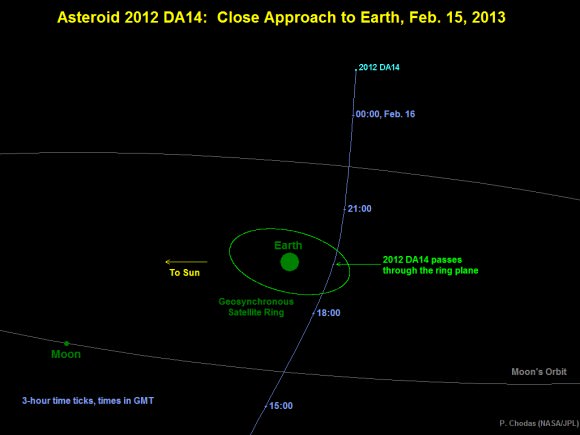
No known asteroid has ever passed so near to Earth.
“This is a record predicted close approach for a known object this size,” stated Yeomans. “Such close flybys happen every 40 years on average. An actual Earth collision would happen about every 1200 years.”
Read also: Asteroid 2012 DA14: Observing Prospects and How to See It
Yeomans said that if an asteroid the size of 2012 DA14 fell to Earth, the impact effect would be similar to the 1908 Tunguska event in Siberia. That was an air blast event that leveled trees over an area greater than about 800 square miles.
So the local effect on human cities for example of a 50 meter wide asteroid impact would be deadly and utterly devastating. But it would not be catastrophic to all life on Earth. Nevertheless, at this moment, Earth has no defenses against asteroids other than talk.
By comparison, the K-T event that caused the mass extinction of the dinosaurs some 65 million years ago was caused by an asteroid about 10 km (6 mi) in diameter. About 2/3 of all species went extinct. If 2012 DA14 impacted Earth the force would be equivalent to about 2.4 megatons of energy (2.4 million tons of TNT), said Yeomans.
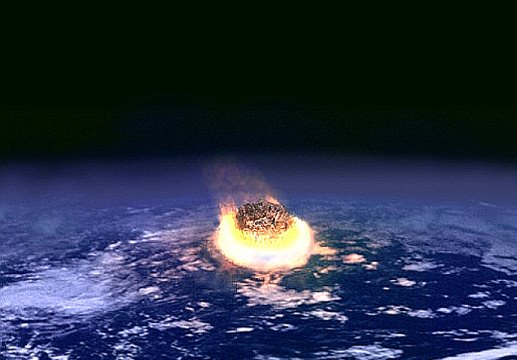
There is no danger to the ISS crew and apparently they won’t have any chance to observe it.
“The ISS is not positioned right for observations,” Lindley Johnson, program executive, Near Earth Object Observations Program, NASA Headquarters, Washington, told Universe Today.
“No NASA space-based assets will be making measurements,” Lindley told me. “The asteroid is moving to fast.”
However, radar astronomers do plan to take images around eight hours after the flyby using the Goldstone antenna in California’s Mojave Desert, which is part of NASA’s Deep Space Network.
Some skilful and knowledgeable Earthlings might have a chance to see the asteroid hurtling by with binoculars or a small telescope.
“The asteroid will be observable in the dark sky in Eastern Europe, Asia and Australia, achieving about 7.5 magnitude, somewhat fainter than naked eye visibility,” explained Yeomans. “Closest approach will be over Indonesia.”
Astronomers at the La Sagra Sky Survey program in southern Spain discovered the asteroid in February 2012 just after its last Earth flyby, at a fairly distant 7 Earth-Moon distances. They reported the finding to the Minor Planet Center.
NASA’s NEO group and collaborators in Pisa, Italy then use such data to predict future flight paths and look into past trajectories as well.
Yeomans said that the Feb 15 flyby will be the closest for the next 100 years and its orbit will be perturbed so that it comes back less frequently – changing its orbital class from Apollo to Aten.
Due to its small size and recent discovery, not much is known about the composition of 2012 DA14. It might be silicate rock.
Small space rocks hit Earth on a daily basis amounting to about 100 tons. Car sized rocks hit weekly.
Stay Alert !
Asteroid Apophis: Bigger, Darker But Not a Threat in 2036
During its close approach this week, observatories from ESA and NASA have made some updates on their assessment of asteroid Apophis and its future encounters with Earth. While the Herschel Space Telescope observations indicates the asteroid is bigger and less reflective than first estimated, scientists at the Jet Propulsion Laboratory have effectively ruled out the possibility that this asteroid will impact Earth during a close flyby in 2036.
Repeat after me: Asteroid Apophis is not a threat to Earth in 2029 or 2036. Got that doomsday prognosticators?
Discovered in 2004, Apophis garnered lots of attention when initial calculations of its orbit indicated a 2.7 percent possibility of an Earth impact during a close flyby in 2029. Data discovered during a search of old astronomical images provided the additional information required to rule out the 2029 impact scenario, but a remote possibility of one in 2036 remained – until now.
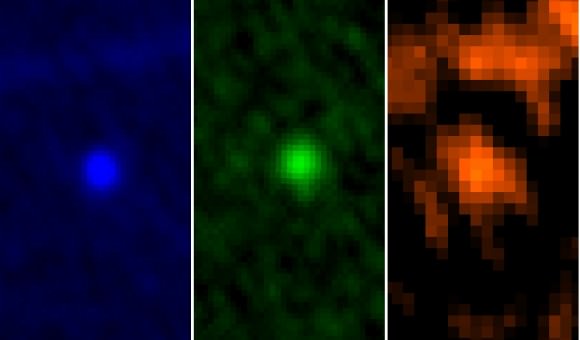
Herschel provided the first thermal infrared observations of Apophis at different wavelengths, which together with optical measurements helped refine estimates of the asteroid’s properties. Previous estimates bracketed the asteroid’s average diameter at 270 ± 60 m; the new Herschel observations returned a more precise diameter of 325 ± 15 m.
“The 20% increase in diameter, from 270 to 325 m, translates into a 75% increase in our estimates of the asteroid’s volume or mass,” says Thomas Müller of the Max Planck Institute for Extraterrestrial Physics in Garching, Germany, who is leading the analysis of the new data.
By analyzing the heat emitted by Apophis, Herschel also provided a new estimate of the asteroid’s albedo – a measure of its reflectivity – of 0.23. This value means that 23% of the sunlight falling onto the asteroid is reflected; the rest is absorbed and heats up the asteroid. The previous albedo estimate for Apophis was 0.33.
Knowing the thermal properties of an asteroid indicates how its orbit might be altered due to subtle heating by the Sun. Known as the Yarkovsky effect, the heating and cooling cycle of a small body as it rotates and as its distance from the Sun changes can instigate long-term changes to the asteroid’s orbit.
Additional data from the Magdalena Ridge Observatory in New Mexico, the Pan-STARRS observatory in Hawaii and the Goldstone Solar System Radar have provided more conclusive evidence when scientists ran the numbers.
“We have effectively ruled out the possibility of an Earth impact by Apophis in 2036,” said Don Yeomans, manager of NASA’s Near-Earth Object Program Office at JPL. “The impact odds as they stand now are less than one in a million, which makes us comfortable saying we can effectively rule out an Earth impact in 2036. Our interest in asteroid Apophis will essentially be for its scientific interest for the foreseeable future.”
But the flyby on April 13, 2029 will be one for the record books, scientists say. On that date, Apophis will become the closest flyby of an asteroid of its size when it comes no closer than 31,300 kilometers (19,400 miles) above Earth’s surface.
“But much sooner, a closer approach by a lesser-known asteroid is going to occur in the middle of next month when a 40-meter-sized asteroid, 2012 DA14, flies safely past Earth’s surface at about 17,200 miles,” said Yeomans. “With new telescopes coming online, the upgrade of existing telescopes and the continued refinement of our orbital determination process, there’s never a dull moment working on near-Earth objects.”
Goldstone radar observations of Apophis will continue through January 17th, and additional tracking is planned next month with the Arecibo radio dish in Puerto Rico, which should provide even more refinements in Apophis’ orbit.
(99942) Lead video: APOPHIS sur fond d’étoiles au Pic du Midi from Francois Colas on Vimeo.
Watch Live Webcast of Asteroid Apophis Earth Flyby
Once again, the Slooh Space Camera team will host a live webcast of an asteroid flyby of Earth. This one might be a bit more intriguing than others, if only because of the connotation this asteroid has. Asteroid Apophis a near-Earth asteroid with an estimated diameter of almost three football fields (270m), is making its closest approach to us this year — but it will still be quite distant, at about 14 million km – but this is close enough for astronomers to study the space rock and assess its future risk.
On Wednesday, January 9th, Slooh.com, will start the webcast at 4 p.m. PST / 7 p.m. EST / 00:00 UTC (1/10) — International times here — accompanied by real-time discussions with Slooh President Patrick Paolucci, Slooh Outreach Coordinator and Engineer Paul Cox, and Documentary Filmmaker Duncan Copp.
Continue reading “Watch Live Webcast of Asteroid Apophis Earth Flyby”
Asteroid Toutatis Tumbles in New Video from NASA
NASA has compiled the radar images taken of Asteroid Toutatis during its flyby of Earth this week to create a short movie, which shows the asteroid slowly tumbling. The 64-frame movie was generated from data gathered on December 12 and 13, 2012 by NASA’s 70-meter Goldstone Deep Space Network antenna in Goldstone, California.
NASA provides more information about the video and (4179) Toutatis:
On Dec. 12, the day of its closest approach to Earth, Toutatis was about 18 lunar distances, 4.3 million miles (6.9 million kilometers) from Earth. On Dec. 13, the asteroid was about 4.4 million miles (7 million kilometers), or about 18.2 lunar distances.
The radar data images of asteroid Toutatis indicate that it is an elongated, irregularly shaped object with ridges and perhaps craters. Along with shape detail, scientists are also seeing some interesting bright glints that could be surface boulders. Toutatis has a very slow, tumbling rotational state. The asteroid rotates about its long axis every 5.4 days and precesses (changes the orientation of its rotational axis) like a wobbling, badly thrown football, every 7.4 days.
The orbit of Toutatis is well understood. The next time Toutatis will approach at least this close to Earth is in November of 2069, when the asteroid will safely fly by at about 7.7 lunar distances, or 1.8 million miles (3 million kilometers). An analysis indicates there is zero possibility of an Earth impact over the entire interval over which its motion can be accurately computed, which is about the next four centuries.
This radar data imagery will help scientists improve their understanding of the asteroid’s spin state, which will also help them understand its interior.
The resolution in the image frames is 12 feet (3.75 meters) per pixel.
Source: NASA
Close Approach Image of Asteroid 2012 XE54
Image of Asteroid 2012 XE54 taken with the the H06 ITelescope network near Mayhill, New Mexico on December 11, 2012, through a 0.25-m f/3.4 reflector + CCD. Credit: Ernesto Guido & Nick Howes, Remanzacco Observatory.
A newly discovered small asteroid named 2012 XE54 passed harmlessly by Earth early today and as predicted it was eclipsed by Earth’s shadow, causing its light to “wink out” for a short time, about 40 minutes.
Above is an image of the asteroid from Ernesto Guido and Nick Howes using a 0.25-m f/3.4 reflector + CCD with the ITelescope facility near Mayhill, New Mexico. It is a single 60-second exposure, “taken with the asteroid at magnitude ~13.2 and moving at ~630 “/min. The asteroid is trailed in the image due to its fast speed. At the moment of the close approach 2012 XE54 will move at ~ 720″/min… North is up, East is to the left,” wrote Guido and Howes on the Remanzacco Observatory website.
Below is an animation showing the movement of 2012 XE54, using three consecutive 60-second exposures. This asteroid was zipping right along at a fast pace, at a distance from Earth of about 226,000 km (141,000 miles) or about .6 lunar distances.
2012 XE54 Animation December 11, 2012, by E. Guido & N. Howes
Pasquale Tricarico of the Planetary Science Institute had predicted that the asteroid would pass through the Earth’s shadow, creating an asteroid eclipse, a rather rare event that is similar to an eclipse of the full Moon by Earth’s shadow. At 01:22 UTC on December 11 the eclipse began, and it left Earth’s shadow at 02:00 UTC. Those watching the asteroid noted that the asteroid “disappeared” from its track, and then reappeared after leaving Earth’s shadow.
“In two images taken at 01:30:16 and 01:31:18, 60sec exposure, 2012 XE54 appeared as a very faint and long track, then… nothing. In the following images there is no visible track. Wonderful!” wrote Elia Cozzi from the New Millennium Observatory, posting in the mpml asteroid research group message board.
Orbital diagram of Asteroid 2012 XE54 from JPL’s Small Body Database.
While we don’t have images to share of that event, as Guido and Howes mentioned, Peter Birtwhistle produced a lightcurve (see graph below) of the eclipse:
Tricarico wrote that the first known case of an asteroid being eclipsed by Earth’s shadow was “Asteroid 2008 TC3 which was totally eclipsed just one hour before entering Earth’s atmosphere over Sudan in 2008, and asteroid 2012 KT42 experiencing both an eclipse and a transit during the same Earth flyby in 2012.”
Guido and Howes also mentioned that their work last night was “in memory of our dear friend & colleague Giovanni Sostero.”
Two Asteroids Will Buzz Past Earth on December 11
Four computer generated views of Asteroid Toutatis based on Goldstone radar imagery. Via NASA
A newly discovered small asteroid named 2012 XE54 and a long-studied giant space rock named Toutatis will buzz past Earth during the next 24 hours, and astronomers are already watching the skies. While there is no danger of either hitting Earth, scientists have much to learn from both. Asteroid 2012 XE54 was discovered over the weekend on December 9 and it will safely pass between the Earth and the Moon’s orbit at a distance of about 226,000 km (141,000 miles) or about .6 lunar distances. Closest approach will be just a few hours after this article was posted, at 10:10 UTC on Dec. 11. But already an interesting event has already happened with this 28-meter-wide asteroid: it was eclipsed by Earth’s shadow. This is quite a rare event, and was visible to astronomers.

This animation shows the Sun and the Earth as observed from the asteroid 2012 XE54. If this eclipse occurs, the asteroid will be in Earth’s shadow. Animation via Pasquale Tricarico
Pasquale Tricarico of the Planetary Science Institute had predicted that the asteroid would pass through the Earth’s shadow, creating an asteroid eclipse, an event that is similar to an eclipse of the full Moon by Earth’s shadow. At 01:22 UTC on December 11 the eclipse began, and it left Earth’s shadow at 02:00 UTC. Those watching the asteroid noted that the asteroid “disappeared” from its track, and then reappeared after leaving Earth’s shadow.
“In two images taken at 01:30:16 and 01:31:18, 60sec exposure, 2012 XE54 appeared as a very faint and long track, then… nothing. In the following images there is no visible track. Wonderful!” wrote Elia Cozzi from the New Millennium Observatory, posting in the mpml asteroid research group message board.
We hope to have images of the event when they become available.
4179 Toutatis, with a shape that has been described as a “malformed potato” will pass at a large distance of 6.9 million kilometers (4.3 million miles) away from Earth, or more than 18 times the distance from the Earth to the Moon.
It is a biggie, though at 4.46 kilometers (2.7 miles) long and 2.4 kilometers (1.5 miles) wide, and is considered a potentially hazardous asteroid because it makes repeated passes by the Earth, about every four years. In comparison, the asteroid that is thought to have destroyed the dinosaurs was approximately 10 km (6 miles) wide.
It’s closest pass will be covered by the Slooh Space Camera on Tuesday, December 11th, with several live shows on Slooh.com, free to the public, starting at 20:00 UTC (12 PM PST / 3 PM EST, find international times here — accompanied by real-time discussions with Slooh President, Patrick Paolucci, and Astronomy Magazine columnist, Bob Berman.
At its maximum brightness, Toutatis might be barely visible through binoculars, but should be very bright through Slooh telescopes at its being tracked.
“We will be tracking Asteroid Toutatis live from two observatory locations – Canary Islands, off the coast of Africa and Arizona,” said Patrick Paolucci, President at Slooh.
Astronomers are interested in this returning asteroid to try and figure out what the asteroid is made of. Also by refining a model of the asteroid’s rotation, they’ll get a better idea of its composition, thereby gaining a greater understanding of the early solar system.
Lance Benner from JPL said that this asteroid is tumbling slowly, but with a complex motion.
“It’s a very peculiar rotation state,” Benner said. “It rotates very slowly and it tumbles in a manner somewhat similar to the way a football tumbles if you screw up a long pass.”
Sources: Slooh, Earth-Sky blog, JPL Small Body database, Planetary Science Institute

